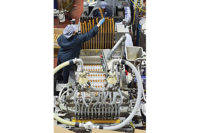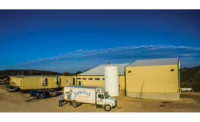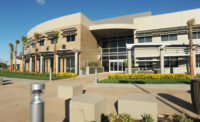Measure what you use and you’ll probably use less
Dairy processors use a lot of water. Fresh water and wastewater can be a huge expense and a significant component of the utilities budget. The H2Oversight Service from U.S. Energy Services, Plymouth, Minn., offers rate tariff optimization, metering equipment confirmation, facility change monitoring, bypass opportunities and identification of operational savings. Dairies benefit from reduced administrative costs, opportunities for efficiencies and savings, and resolution of past billing and metering inefficiencies, said Gail McMinn, an executive vice president at the company.
Recover water from milk and re-use it for washing, landscaping
There’s an old saying: “You pay for water twice. Once when you buy it and again when you treat it.” Processors that re-use water buy less and dispose of less into a municipal sewer system.
Hilmar Cheese Co., Hilmar, Calif., says it recovers almost all of the water found in milk. The reclaimed water is used to wash facilities and equipment, to irrigate the landscaping around the buildings, to irrigate crops which are fed to cows and for non-food uses. The recovered water accounts for more than 60% of the water used at the cheesemaker’s facilities in Hilmar and Dalhart, Texas.
Use cold plate technology to reduce truck costs
Clover Stornetta Farms is an organic dairy operation in Petaluma, Calif. Some of its bobtail trucks (shown are other vehicles) run cleaner these days because cold plate technology (not diesel fuel) keeps the dairy products cool. The trucks are quieter, too, because there is no diesel-powered refrigeration unit. The trucks are plugged in at night during off peak hours, and are able to maintain the necessary “just above freezing” temperature for 48 hours. The company says cold plate technology costs up to seven times less annually than running diesel in the refrigeration units. By the way, the fleet maintenance facility is green, too. It’s solar-powered.
Make product packages lighter in weight
Lighter-weight packaging requires less material, and lighter packages require less fuel to transport. When Land O Lakes, Arden Hills, Minn., redesigned the container for its light butter with canola oil, it took out 10% of the packaging material. The dairy processor’s cross-functional Sustainable Packaging Team worked on six projects that reduced packaging volume by 163 tons in one year alone.
Manage the costs of process water with technology
The Nestlé Waters North America bottling facility in Hawkins, Texas, installed a technology system for cooling water, boiler water and membrane operations. The technology helps to conserve water and energy use and increases production efficiency. 3D Trasar technology from Nalco, St. Paul, Minn., measures key system parameters, detects upsets and takes corrective action to maximize operating efficiency in cooling water, boiler water and membrane systems.
Set goals but don’t sit back. Review progress, revise targets.
Dean Foods, Dallas, revised its 2020 environmental sustainability goals this summer and added new ones. Dean revised its 2013 Environmental Roadmap, which called for reductions in greenhouse gases (20%), water use (30%) and solid waste (30%). The nation’s largest dairy processor expanded its original goals and said it added more achievable timelines. The company will set new goals for zero-waste plants, packaging and sustainable supply by the end of 2013.
Dean said at its current pace, it will miss its 2013 greenhouse gas and water goals because of volume declines and more water-intensive processes from an expanding product portfolio. The company has reduced solid waste 21%, increased recycling by more than 50%, and reduced distribution fleet carbon dioxide equivalent emissions.
Turn off the lights. Yes, it really helps
A Dairy Farmers of America facility in Springfield, Mo. upgraded lighting, installed motion detectors/light level detectors, turned off the lights on weekends and labeled light switches with reminders to employees to turn them off when not in use. For these efforts and others, the facility received a Gold Level award from Ozarks GreenScore, which recognized the plant’s commitment to sustainability.
Other activities that helped the processing plant attain Gold Level status include:
• Replacing 70% of roofing with increased insulation levels and white, reflective material
• Partnering with Drury University, Springfield, and interns to investigate water-saving techniques in the main plant
• Improving the plant’s compressed air system with upgrades to piping and controls and establishing a leak-check program
• Purchasing high-efficiency motors and replacing inefficient units
• Working on waste-recycling projects. These generated more than $89,000 in grants to install waste-recycling equipment
nDairy Farmers of America Sustainability Team members meet with representatives from Ozarks GreenScore and the city of Springfield, Mo. From left: Jim Hopwood; Amy Strickland-Minor, Ozarks GreenScore and Drury University Ozarks Center for Sustainable Solutions; Mike Schick; Chris Stefaniw; Brad Akin; Joyce Breesawitz; Springfield Mayor Bob Stephens; Levi White; John Carr; Ralph Siccama; Gerriann Marvin; Dana Lowe, plant manager; John McGuire; Allan Craig; Sara Garretson, city of Springfield; and Bob Gaeke.
Collaborate with others on LCA measurement tools
International food and beverage giant Nestlé joined a new industry/academia research partnership that aims to improve the environmental performance of consumer products and services. The company said it is the only global food and beverage manufacturer to join the International Chair in Life Cycle Assessment unit at the Interuniversity Research Centre for the Life Cycle of Products, Processes and Services (CIRAIG) in Montreal.
As part of its product development process, Nestlé also conducts quicker versions of life-cycle assessments using what it calls “simple eco-design tools.” One of these is the Packaging Impact Quick Evaluation Tool (PIQET), which evaluates the environmental impact of packaging over its entire lifecycle. The company says such tools allow it to evaluate lifecycle data early in the design stage so it can make modifications while packaging is still being developed.
Involve all employees in achieving green goals
Yogurt maker Dannon, White Plains, N.Y., uses a cross-functional Green Team — made up of employees throughout the company, from manufacturing operations to marketing — to achieve its green goals. In 2011, the dairy processor reduced its carbon footprint by 5.9% (a total reduction of more than 29% since 2008). Approximately 93% of manufacturing waste was recycled at Dannon factories, an 18% improvement from 2010. By modernizing its processing plants, Dannon said it reduced water use by more than 30% from 2008 to 2011.
Mom always said: ‘Don’t waste food.’ It’s good advice for processors, too.
Valio, a dairy processor based in Helsinki, Finland, seeks to reduce or re-use packaging and food waste. The company sends all faulty batches of fresh dairy products (and products returned from retailers) to a facility where liquid products are separated from the packages. The product waste is used as animal feed. Batches not suitable for use as animal feed are used to produce biogas.








